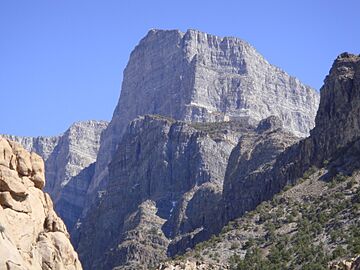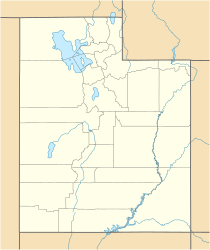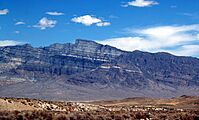Notch Peak facts for kids
Quick facts for kids Notch Peak |
|
|---|---|

Notch Peak, from the canyon below the notch
|
|
| Highest point | |
| Elevation | 9,658 ft (2,944 m) NAVD 88 |
| Prominence | 3,414 ft (1,041 m) |
| Listing | Great Basin Peaks List |
| Geography | |
| Location | Millard County, Utah, U.S. |
| Parent range | House Range |
| Topo map | USGS Notch Peak |
| Climbing | |
| Easiest route | Hike |
Notch Peak is a very special mountain in Utah, United States. It's part of the House Range and is located west of Delta. The mountain and the land around it are protected as a Wilderness Study Area. You can find some amazing Bristlecone pine trees here. Some of these trees are thought to be 3,000 to 4,000 years old! That means they were growing when ancient civilizations were just starting.
Contents
The Giant Cliff Face
Notch Peak is one of the tallest mountains in the House Range. It stands at 9,658 feet (2,944 m) high. But what makes it truly famous is its huge northwest side. This side is a massive cliff made of limestone and dolomite rock. It drops straight down for about 2,200 feet (670 m)! This makes it one of the tallest cliff faces in all of North America. From the valley below, the top of the mountain rises about 4,450 feet (1,360 m).
This incredible cliff is the second-highest pure vertical drop in the United States. Only El Capitan in Yosemite National Park is taller. It's also the tallest cliff made of carbonate rock in North America.
Fun Things to Do
Many people enjoy visiting Notch Peak to hike and see its amazing views.
Hiking to the Top
One of the most popular activities is hiking to the very top of Notch Peak. From the summit, you can look down into the famous "notch" that gives the mountain its name. The hiking trail starts on the east side of the mountain in Sawtooth Canyon. The round trip hike is about 7.5 miles (12 km) long. You will climb about 2,600 feet (790 m) in elevation to reach the peak.
Challenging Rock Climbing
The north face of Notch Peak is a big challenge for experienced rock climbers. This huge cliff is split into an upper and lower section by a large shelf. There are several very difficult climbing routes on these limestone cliffs. Some famous routes on the upper part include The Swiss Route and Pillars of Faith. On the lower part, climbers tackle routes like Appetite for Destruction. Climbing here is very adventurous, but climbers must be careful of falling rocks.
How the Mountain Was Made
The rocks that make up this part of the House Range are very old. They are mostly carbonate rocks, like limestone and dolomite, formed during the Cambrian and Ordovician periods. These periods were hundreds of millions of years ago! The rocks at the very top of the mountain are even named after it: the Notch Peak Dolomite.
At the base of the mountain, you can find pink and orange rocks called granite and monzonite. These rocks are from the Jurassic period, which was about 143 to 169 million years ago. That's when dinosaurs roamed the Earth! Also, if you look closely from the west side of Notch Peak, you might see white, soft rocks with fossils. These are from an ancient lake called Lake Bonneville that once covered much of Utah.
If you hike up the canyon below the notch, you can see how hot, melted rock (called an intrusion) pushed its way into the older rocks. This heat changed the surrounding rocks, creating interesting patterns. Sometimes, small amounts of tungsten and even tiny bits of gold have been found around the Notch Peak area.
Images for kids







